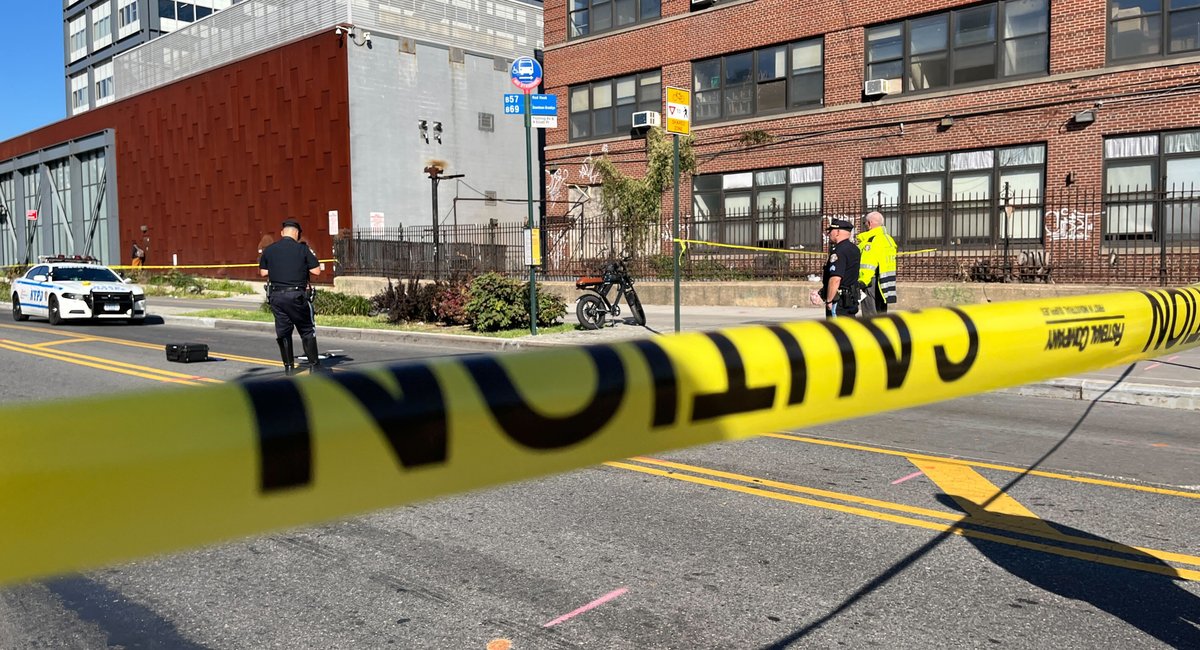This column originally appeared in On The Way, a weekly newsletter covering everything you need to know about NYC-area transportation.
Sign up to get the full version, which includes answers to reader questions, trivia, service changes and more, in your inbox every Thursday.
E-bikes are everywhere in New York City, and they’re growing faster, cheaper and harder to regulate.
This week’s death of a 60-year-old woman who was run over by a pair of riders doubled up on an e-bike cruising on the Flushing Avenue bike lane outside the Brooklyn Navy Yard highlights a crisis that city officials have let simmer for years.
The bike, made by the company Movcan, is not street-legal in the five boroughs. It sells for as little as $700, around the same price as many regular bicycles, and is advertised as reaching 30 mph. City officials said it’s the type of vehicle that needs to be registered with the state Department of Motor Vehicles. (It was not, and had no license plate.)
But it’s unclear how law enforcement officers could discern what’s allowed, and what’s banned.
“The problem is if you have tens of thousands of these vehicles on the street, you have no enforcement mechanism for the police to differentiate between what’s legal and what’s illegal,” said Nicole Gelinas, a senior fellow at the Manhattan Institute. “And room for so many more illegal vehicles to just skate through because we’re just overwhelmed on the enforcement side.”
The e-bike problem is yet another example of technology evolving far faster than regulations. E-bikes, which have boomed over the last decade, have been billed as a convenient, eco-friendly mode of transportation, and as a way to help the city’s delivery workers meet New Yorkers’ ever-growing demand for door-to-door service.
But city data shows at least 638 people were injured and 17 were killed in crashes involving e-bikes last year. There are at least 65,000 deliveristas on city streets, and e-bike sales across the country have gone way up since the pandemic.
Gelinas said micromobility companies should get credit for the innovation that fueled the growing popularity of e-bikes. But she noted that tech-fueled progress also involves outfoxing city officials.
“Some of it is just the tech industry being smarter than the city government. I think the more pernicious part is they build up a sort of constituency of activist, militant consumers,” she said.
Even with some laws in place, the efforts to address speeding and other issues around e-bikes have either been met with a heavy hand or a blind eye, without much nuance.
Mayor Eric Adams’ 15 mph speed limit for e-bikes is set to go into effect next week. But it remains unclear how it will be enforced, and doesn’t solve for an industry that cranks out cheap e-bikes that move as fast as a motorcycle.
The City Council passed another effort to rein in delivery workers on e-bikes last month. It would require them to wear vests and take a safety course.
“I can tell you from my perspective, I cannot take any more calls about e-bikes, that’s for sure,” City Councilmember Gale Brewer, who introduced the bill, told Gothamist. “I am very, very conscious of it and pushed as hard as I could.”
But observers like Gelinas said these efforts aren’t keeping pace with the reality on the streets.
“I also think the city government [is] just not realizing how fast these things just take off,” Gelinas said.
The chaotic dynamics on the roads are reminiscent of past regulatory fiascos.
About a decade ago, the boom of Uber and other e-hail apps presented a similar problem. City officials had no clue how to regulate the brand new industry. And within a matter of years, officials rolled over while the companies flooded New York with more than 80,000 new for-hire vehicles.
“ You don’t really know the beast you have in hand until you have it in hand, and then you’re behind the curve,” Bruce Schaller, a former transportation official and consultant, told Gothamist. “But if you try and anticipate, it’s hard to know quite what to do because it’s so unfamiliar and you have no experience with it. And so that’s the conundrum at a high level. How do you regulate this stuff before you know what it is?”
Schaller said the city should look back to how it dealt with a flood of nearly 35,000 unlicensed outer borough taxis or “gypsy” cabs in the 1980s for guidance.
“The solution to this stuff is to define the most egregious behavior and then have legal authority to seize the vehicle,” Schaller said. “I can tell you like in the 1980s when TLC was first getting its arms around car services the agency towed thousands of cars and that’s what it took to get control of that industry.”
Question from Susan in Queens
Does the future switch in tunnels between the M and the F mean that the F will no longer stop at 63rd and Lex?
Answer
That’s exactly what it means. Later this year, when the lines swap East River tubes, M trains will run along 63rd Street, with F trains running beneath 53rd Street.
Some fun facts about these tubes: Today, the F train runs through the 63rd Street East River tunnel, which has two levels. Subways run on the upper part and the Long Island Rail Road runs on the lower. The MTA began construction on the tube in 1969, but didn’t start running subway trains through it until 1989. It took until 2023 for LIRR trains to use the lower level thanks to decades of delays and mishaps with the MTA’s East Side Access project. LIRR trains now travel on the lower level to Grand Central Madison.
Farther south, the M train runs through the reliable old 53rd Street tunnel, which also carries the E line.
That crossing dates back to the 1930s, when New York City was churning out new subway lines like ticker tape.
